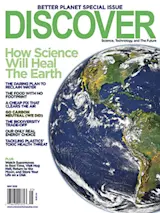Two and one-tenth pounds of carbon dioxide. That is our best estimate of what is emitted into the atmosphere when we harvest trees, turn the freshly milled paper into your individual copy of DISCOVER, get it into your hands, and see it to its final resting place. For comparison, this is the same amount of CO2 produced by twelve 100-watt lightbulbs glowing for an hour or a car engine burning 14 ounces of gasoline.
As a publication that keeps a close eye on the state of the planet, DISCOVER decided it was time to look in the mirror and take stock of our own contribution to the greenhouse-gas problem. That means accounting for greenhouse-gas emissions due to all the processes from harvesting, milling, and printing to shipping, recycling, and stowing in landfills: looking at every step of the magazine’s life cycle.
To define the scope of our analysis and set ...















